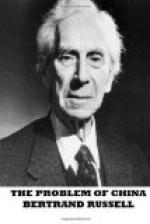FOOTNOTES:
[Footnote 97: It should be said that one sees just as fine buildings in purely Chinese institutions, such as Peking Government University and Nanking Teachers’ Training College.]
[Footnote 98: Mr. Tyau (op. cit. p. 27) quotes from Who’s Who of American Returned Students, a classification of the occupations of 596 Chinese who have returned from American universities. The larger items are: In education, 38 as administrators and 197 as teachers; in Government service, 129 in executive offices (there are also three members of Parliament and four judges); 95 engineers; 35 medical practitioners (including dentists); 60 in business; and 21 social and religious workers. It is estimated that the total number of Chinese holding university degrees in America is 1,700, and in Great Britain 400 (ib.). This disproportion is due to the more liberal policy of America in the matter of the Boxer indemnity. In 1916 there were 292 Chinese university students in Great Britain, and Mr. Tyau (p. 28) gives a classification of them by their subjects. The larger groups are: Medicine, 50; law and economics, 47; engineering, 42; mining, 22; natural science (including chemistry and geology, which are classified separately), 19.]
CHAPTER XIV
INDUSTRIALISM IN CHINA
China is as yet only slightly industrialized, but the industrial possibilities of the country are very great, and it may be taken as nearly certain that there will be a rapid development throughout the next few decades. China’s future depends as much upon the manner of this development as upon any other single factor; and China’s difficulties are very largely connected with the present industrial situation. I will therefore first briefly describe this situation, and then consider the possibilities of the near future.
We may take railways and mines as the foundation of a nation’s industrial life. Let us therefore consider first the railways and then the mines, before going on to other matters.
When railways were new, the Manchu Government, like the universities of Oxford and Cambridge (which it resembled in many ways), objected to them, and did all it could to keep them at a distance.[99] In 1875 a short line was built by foreigners from Shanghai to Woosung, but the Central Government was so shocked that it caused it to be destroyed. In 1881 the first permanent railway was constructed, but not very much was accomplished until after the Japanese War of 1894-5. The Powers then thought that China was breaking up, and entered upon a scramble for concessions and spheres of influence. The Belgians built the important line from Peking to Hankow; the Americans obtained a concession for a Hankow-Canton railway, which, however, has only been constructed as far as Changsha. Russia built the Manchurian Railway,




